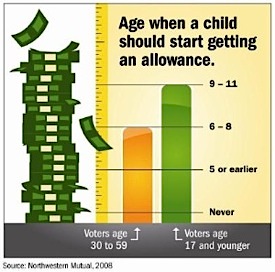Kids and Allowances
I can tell you from experience that my children LOVE allowances BUT hate chores. How do you make it fun for kiddos who only want the money? Well, just like us, we have to work for it/ Teaching them at a young age not only gives them the ability to learn how to earn what they work for, but it teaches them how to understand the meaning of what earning "money" (allowance) truly is. Many parents start early, explaining the whole process of earning,
saving and spending to their children as soon as they understand that
their cool piggy banks aren’t just toys, but are also great financial tools.
#1. An allowance is not a bribe. Try not to make the allowance dependent on the kids completing the chores they’re already expected to do. This can create a bad habit of them only wanting to help because they expect something in return. I also don’t believe in making the allowance a basis for a threat of losing it as punishment. I believe an allowance should always be given once established and negotiations be made otherwise. Not all experts agree with this, in fact, Suze Orman thinks it’s a really bad idea to give them an allowance if they haven’t “earned” it by doing work-pay chores. She even suggests starting at age 4. Apparently this will teach them to not feel entitlement with money. I just feel prefer to make the allowance a way to teach her to make responsible choices about money, and have her complete her chores otherwise. I don’t think a 4-year old needs to be learning about work just yet!
#2. Let them make their own choices. Before you give your kid his first allowance, make sure you’ve already talked about money and the choices she can make with it. She can choose to save it for something she’s really been wanting, or put some of it away and spend the rest, or just donate some. When shopping together for a toy, teach her to know how much each item costs and which one would be the best choice for the money.
#3. Use cash as much as possible. Yes, I know this is getting harder and harder to do, but for kids — and even for adults! — it’s very difficult to get a sense of how much money they have if they can’t see and feel the coins and bills. Passing a card through is just too abstract for this process.
#4. Lead by example. I’ve recently been starting to feel guilty when I take my girl to the store with me and I won’t allow her to buy more stuff and then I walk out with a bag load for myself. How is that teaching her to value money and only purchase what she needs? Maybe the solution is to do my shopping without her? Yeah, there we go!
#5. Teach them to think about big purchases before making them. I find that this exercise applies to myself really well to stop me from impulse purchases. Make it good practice that if your kid sees something he really, really wants to ask him to think about it overnight and if he still feels strongly about it the next day, then he can use his money to buy it. A great tip that has worked for us is to take a picture of the item while at the store with the intention of remembering it later. Not once has she come back the next day to ask about it, at least not yet.
#6. Don’t just tell her money doesn’t grow in trees, show her. Encourage her to have a lemonade stand or bake sell or anything she wishes to make and sell. This will teach her the value behind the concept of making money and working, just like her mom and dad do to bring in the money she gets. You can also use it to teach her about investing her own money to put the stand together and seeing if she makes or losses.
 #7. Make it a routine. Establish a day of the week
when he will get his allowance and stick to it. Children of all ages
strive on routines and this helps him monitor his money and how/when to
spend or save.
#7. Make it a routine. Establish a day of the week
when he will get his allowance and stick to it. Children of all ages
strive on routines and this helps him monitor his money and how/when to
spend or save.
Now for some parents, “above and beyond” includes chores and good
grades, while for others, such good actions won’t count toward rewards
since this behavior is what they already expect from their child. And
there are those families that have the “earn your own allowance” policy.
Whichever way you go would depend on your parenting style.



Comments
Post a Comment